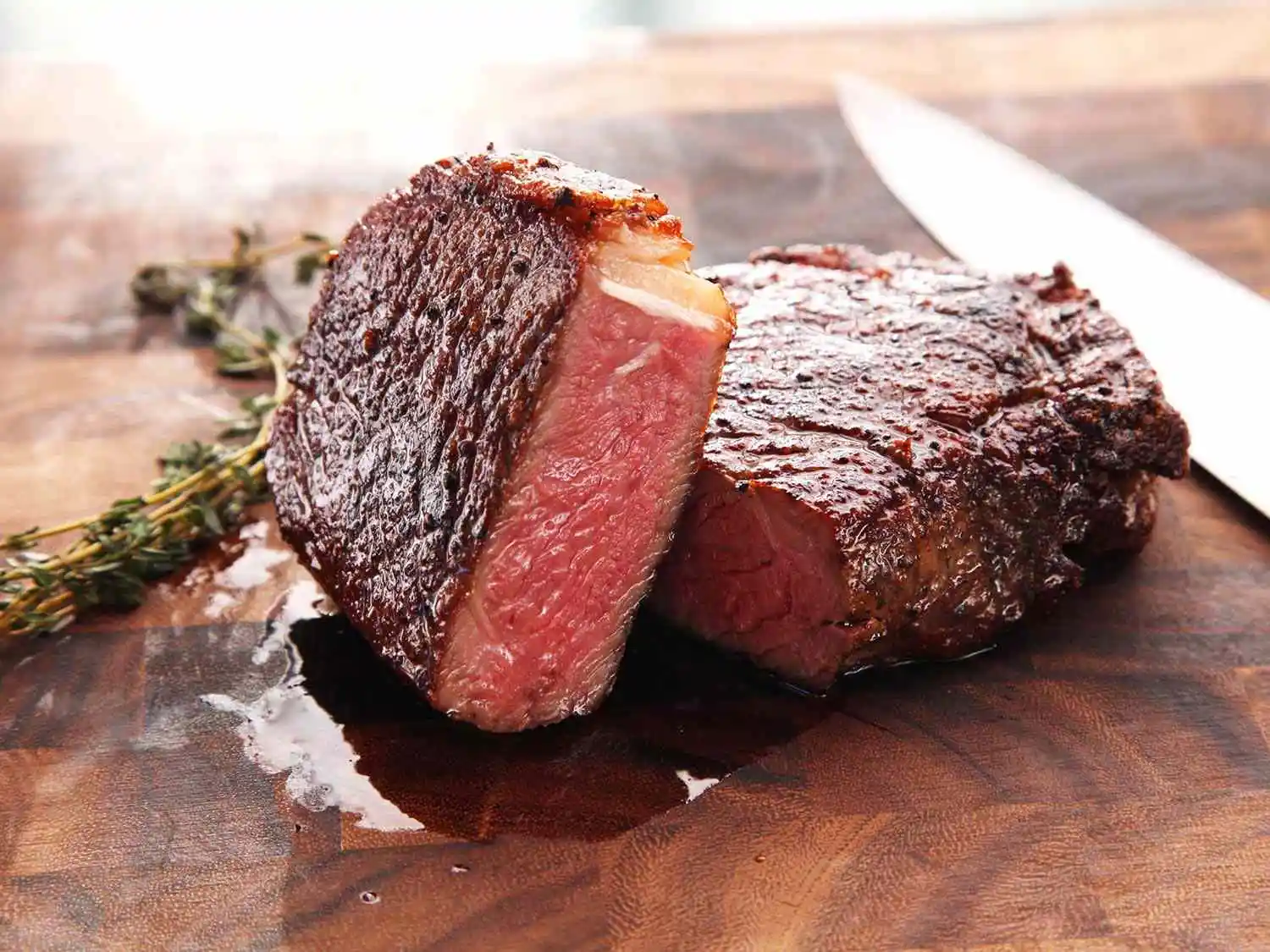Why YSK: When you cook meat, any water on the surface must first evaporate before much browning can occur. You want to get as much of a Maillard reaction as possible in the limited cooking time you have before the meat reaches the correct internal temperature. Removing the moisture first means that the heat of the cooking surface isn’t wasted on evaporation and can instead interact with the meat to form the complex sugars and proteins of the Maillard reaction.



And if it’s steak especially, leave it out for a half hour to get closer to room temp before cooking.
Ever since I learned this tip I’ve been cooking perfect steaks. Makes a huge difference.
And you can leave it uncovered in the fridge (use a rack and a drip pan) and the airflow will dry the outside. This gives a better sear overall.
If you don’t have the time (or the foresight) to salt it hours ahead, the next best alternative is to salt RIGHT before cooking. If you salt 10-30 minutes before, osmosis will draw moisture out of the meat, which will then either be wiped away or evaporated. Salting hours ahead of time gives the moisture time to diffuse back into the meat with the salt it dissolved.
This is the right tip. If you can’t dry brine with salt overnight, then salt right before you hit heat.
That being said, give me a 24 dry brine plus reverse sear any day.
Absolutely. Long dry brine is the preferred method, but if you just remember an hour before it’s rime to cook, it’s better to wait until just before it goes in the pan.
I personally prefer just straight on the pan after a dry brine instead of reverse sear, but that’s probably because I prefer it cooked rare.
And ALWAYS rest your meat after cooking it before slicing into it for 10 minutes or so
I do this all meats, especially skin-on chicken. Gets that perfect crispy skin every time
OOoo I haven’t tried that, I’ll do that next time.
This
This has virtually no impact. Salt is more important.
Depends on how you’re cooking. It’s all about that heat gradient!
Out on an open grill on medium heat for 20 minutes? Yeah, literally zero difference.
Pan fried on a cast-iron skillet that you’ve cranked up to ludicrous mode? That shit better be room temp if you want the inside to reach a safe temperature!
… and to those of you who cook steak but have never panfried: what are you doing? Get yourself some peanut oil, crank the heat to 11, and get cooking ASAP. Look up a guide because nailing the doneness will be hard, but I guarantee you that you’ll become a better cook after a few attempts. It’s a rite of passage, my fellow meatheads.
In the case of your own fried/ludicrous mode example, leaving the steak out at room temperature for even a few hours has basically no effect. It takes a long time for the bulk of the steak to warm any appreciable amount.
https://www.seriouseats.com/old-wives-tales-about-cooking-steak#toc-myth-1-you-should-let-a-thick-steak-rest-at-room-temperature-before-you-cook-it
“After the first 20 minutes—the time that many chefs and books will recommend you let a steak rest at room temperature—the center of the steak had risen…not even a full two degrees…After 1 hour and 50 minutes, the steak was up to 49.6°F in the center”
I use a meat thermometer to gauge when it’s room temp, so I know how long it takes (spoiler: about a day).
I’m not great about food safety so keeping meat out that long is usually a recipe for food poisoning – that’s why I cheat by putting it in the microwave on 10% power for 3 rounds of 5 minutes. This usually gets the steak 90% of the way to room temp with minimal cooking (this obviously varies a lot by wattage and cut, that’s why thermometers are useful!). After that, I wrap the steak in cling-wrap and let it rest on the counter for another hour (the wrap helps prevent evaporative cooling) which gets the steak the rest of the way to room temperature.
Thermometers ftw.
I’m just out here trying to do an entire meal on the bbq
I can never get the rice quite right
A fresh steak should be safe to eat raw. I’ve never heard of a target temp for food safety for steak either tbh.
If anything bringing steak to “room temp” would be more likely to bring it in a danger zone.
Well… believe it or not there is a suggested internal temperature for cooking beef, even if it’s not ground. The CDC recommends 145F (~63C) and FSA recommends 70C (~158F). It’s certainly true that beef is one of the safer meats to eat at undercooked temperatures (at least in the U.S. & U.K.), but it’s also true that you can achieve just about any level of doneness beyond blue while still following food safety guidelines.
As I’ve said elsewhere, I have difficulty maintaining a super-sterile kitchen, so I can’t practically leave meat out at room temperature all day without risking food poisoning. I instead opt to expedite the process by microwaving at low power. Even if you view these guidelines as silly, there remains the practical application of being able to sear thicker cuts without leaving an overly raw center. When your total cook-time is <5 minutes, these things matter.
Cooking a fresh steak to 63 degrees sounds like a waste of money to me. ( And so does cooking chicken to 70) But I think we can all agree to that because we know those are the temperatures that indicate safety if it reaches that for 1 second. And lower temperatures over time are also good.
Generally I prefer reverse searing steak because it allows for a tender perfect inside with a hard crust and no gradients in the doneness. But if I don’t have time for that (or for a sous vide waterbath) I just cook straight out of the fridge in a cast iron while flipping every thirty seconds. And for anyone doubting that flipping 30 seconds is superior to not touching it before flipping once: your steaks will be less evenly cooked which I don’t like but you are free to do so ofcourse. Read Kenji’s article on it if you don’t believe me: https://www.seriouseats.com/the-food-lab-flip-your-steaks-and-burgers-multiple-times-for-better-results
Letting it reach room temp contributes little to nothing, in comparison with patting it dry, because of a few details:
So if you don’t wait until your beef reaches room temperature before cooking it, you’re losing, like, 20cal per gram of beef to unnecessarily raise its temperature. However if you don’t pat your beef dry, each gram of water soaking there will be stealing 75cal to rise its own temperature to 100°C, plus 540cal to steam off. And since browning is a surface reaction and the offending water is mostly on the outside the difference is fairly big, as you aren’t comparing the whole chunk of beef with the outside water - you’re only comparing the surface beef with the water.
(I hope that this is clear, I’m damn convoluted to explain stuff.)
Rest it for 2 hours at room temp with salt on salt on it
oooh. salt on salt action.
I’ve never seen a comparative experiment that confirms this habit and I don’t see how that would make a difference. Especially not if you use a thermometer.
Empirical evidence suggests that it takes many hours for the center of the steak, the part that matters for doneness, to rise any appreciable amount.
Drying the outside of your steak is good advice because your can see the results. The same with brining because you can taste it.
If your technique is otherwise good whether that’s low/slow or hot/fast then “letting it warm up” is just bunk advice.
Another note is that if your cooking set up can’t crank up high enough to get a good sear fast then you may benefit from the center being cold to start with to give you more time to develop the crust.